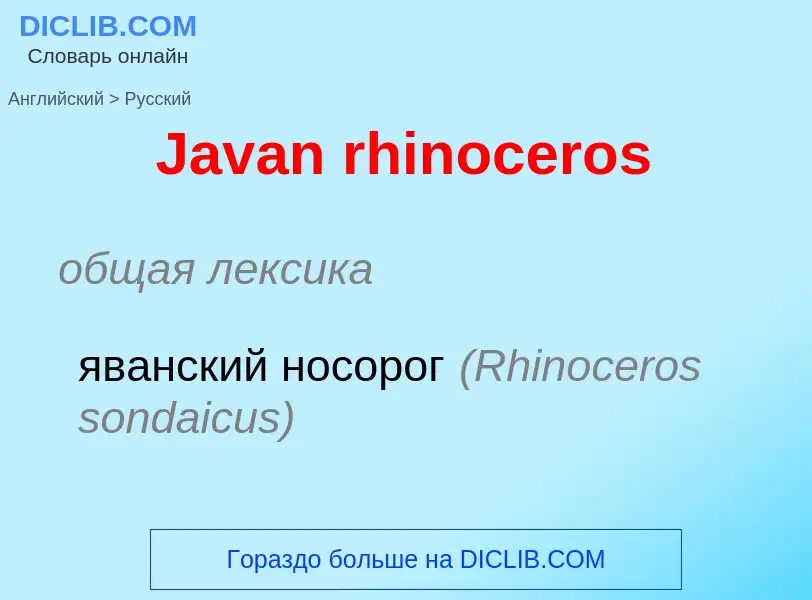Перевод и анализ слов искусственным интеллектом ChatGPT
На этой странице Вы можете получить подробный анализ слова или словосочетания, произведенный с помощью лучшей на сегодняшний день технологии искусственного интеллекта:
- как употребляется слово
- частота употребления
- используется оно чаще в устной или письменной речи
- варианты перевода слова
- примеры употребления (несколько фраз с переводом)
- этимология
Javan rhinoceros - перевод на Английский
общая лексика
яванский носорог (Rhinoceros sondaicus)
['rain|əu]
существительное
['rainəu]
разговорное выражение
см. rhinoceros
деньги
звонкая монета
сокращение
of rhinoceros
общая лексика
индийский носорог (Rhinoceros unicornis)
синоним
Википедия

The Javan rhinoceros (Rhinoceros sondaicus), also known as the Javan rhino, Sunda rhinoceros or lesser one-horned rhinoceros, is a very rare member of the family Rhinocerotidae and one of five extant rhinoceroses. It belongs to the same genus as the Indian rhinoceros, and has similar mosaic, armour-like skin, but at 3.1–3.2 m (10–10 ft) in length and 1.4–1.7 m (4.6–5.6 ft) in height, it is smaller (closer in size to the black rhinoceros of the genus Diceros). Its horn is usually shorter than 25 cm (9.8 in), and is smaller than those of the other rhino species. Only adult bulls have horns; cows lack them altogether.
Once the most widespread of Asian rhinoceroses, Javan rhinos ranged from the islands of Java and Sumatra, throughout Southeast Asia, and into India and China. The species is critically endangered, with only one known population in the wild, and no individuals in captivity. It is possibly the rarest large mammal on Earth,: 21 with a population of approximately 74 in Ujung Kulon National Park at the western tip of Java in Indonesia. The Javan rhinoceros population in Vietnam's Cat Tien National Park was declared to be locally extinct in 2011. The decline of Javan rhinos is attributed to poaching, primarily for their horns, which are highly valued in traditional Chinese medicine, fetching as much as US$30,000 per kg on the black market.: 31 As European presence in their range increased, trophy hunting also became a serious threat. Loss of habitat, especially as the result of wars, such as the Vietnam War, in Southeast Asia, has also contributed to the species' decline and hindered recovery. The remaining range is within one nationally protected area, but the rhinos are still at risk from poachers, disease, and loss of genetic diversity leading to inbreeding depression.
Javan rhinos can live around 30–45 years in the wild. They historically inhabited lowland rain forest, wet grasslands, and large floodplains. They are mostly solitary, except for courtship and offspring-rearing, though groups may occasionally congregate near wallows and salt licks. Aside from humans, adults have no predators in their range. Javan rhinos usually avoid humans. Scientists and conservationists rarely study the animals directly due to their extreme rarity and the danger of interfering with such an endangered species. Researchers rely on camera traps and fecal samples to gauge health and behavior. Consequently, Javan rhinos are the least studied of all rhino species. Two adult Javan rhinos with their calves were filmed in a motion-triggered video released on 28 February 2011 by WWF and Indonesia's National Park Authority, which proved it is still breeding in the wild. In April 2012, the National Parks Authority released video showing 35 individual Javan rhinos, including mother/offspring pairs and courting adults. There are only 58 to 68 individuals left in the wild, and none in captivity, after the death of a bull named Samson. Samson died in April 2018 at 30 years of age, far younger than the species' usual lifespan of 50 to 60 years, so DNA testing is being conducted to explore the cause of death, including the possibility of inbreeding degeneration.






![The [[Indian rhinoceros]] pictured here is the species most closely related to the Javan rhinoceros; they are the two members of the [[type genus]] ''Rhinoceros''. The [[Indian rhinoceros]] pictured here is the species most closely related to the Javan rhinoceros; they are the two members of the [[type genus]] ''Rhinoceros''.](https://commons.wikimedia.org/wiki/Special:FilePath/Panzernashorn2004.jpg?width=200)

![Java's [[Ujung Kulon National Park]] is the home of all remaining Javan rhinos. Java's [[Ujung Kulon National Park]] is the home of all remaining Javan rhinos.](https://commons.wikimedia.org/wiki/Special:FilePath/Ujungkulon.jpg?width=200)

.png?width=200)



![[[Western Zhou]] bronze rhino [[Western Zhou]] bronze rhino](https://commons.wikimedia.org/wiki/Special:FilePath/Shan-Shan Museum - Western Zhou Bronze Rhino Zun.jpg?width=200)
 4.jpg?width=200)

![''[[Dürer's Rhinoceros]]'' ''[[Dürer's Rhinoceros]]''](https://commons.wikimedia.org/wiki/Special:FilePath/Dürer's Rhinoceros, 1515.jpg?width=200)
![Indian rhinoceros in [[Manas National Park]] Indian rhinoceros in [[Manas National Park]]](https://commons.wikimedia.org/wiki/Special:FilePath/Indian One Horned Rhino.jpg?width=200)
![Chandra Shumsher JBR]] with a slain rhino during a hunt (December 1911) Chandra Shumsher JBR]] with a slain rhino during a hunt (December 1911)](https://commons.wikimedia.org/wiki/Special:FilePath/King George V Hunting in Nepal (19).jpg?width=200)
![Indian rhinoceros in [[Chitwan National Park]], Nepal Indian rhinoceros in [[Chitwan National Park]], Nepal](https://commons.wikimedia.org/wiki/Special:FilePath/One-horned Rhinoceros at Chitwan National Park.jpg?width=200)

![Indian rhinoceros at [[Bardia National Park]] Indian rhinoceros at [[Bardia National Park]]](https://commons.wikimedia.org/wiki/Special:FilePath/One horned Rhino.jpg?width=200)
![Mughal emperor]] [[Babur]] on a rhino hunt, 16th century. Mughal emperor]] [[Babur]] on a rhino hunt, 16th century.](https://commons.wikimedia.org/wiki/Special:FilePath/RhinoHuntBabur.jpg?width=200)

.jpg?width=200)


